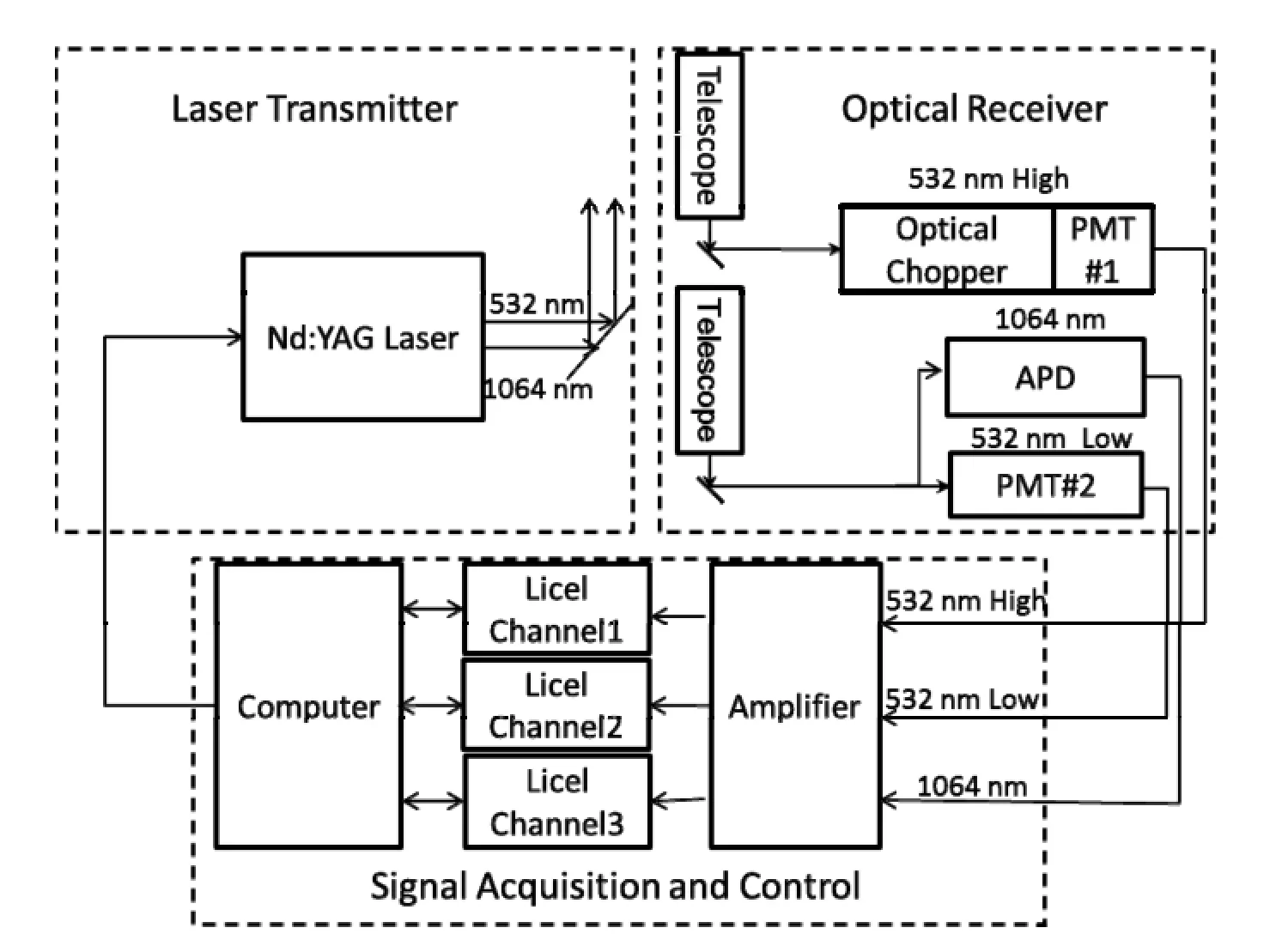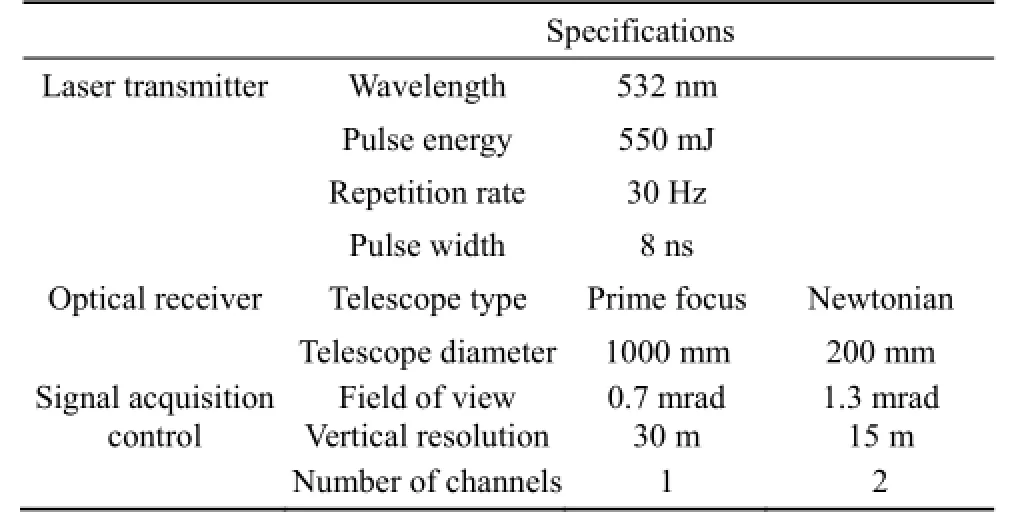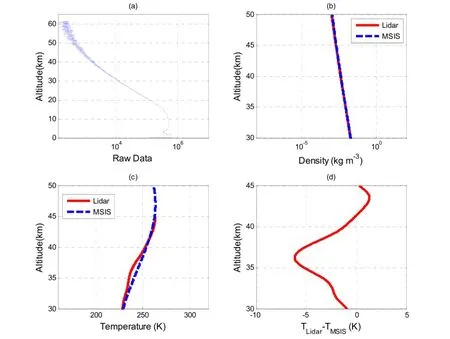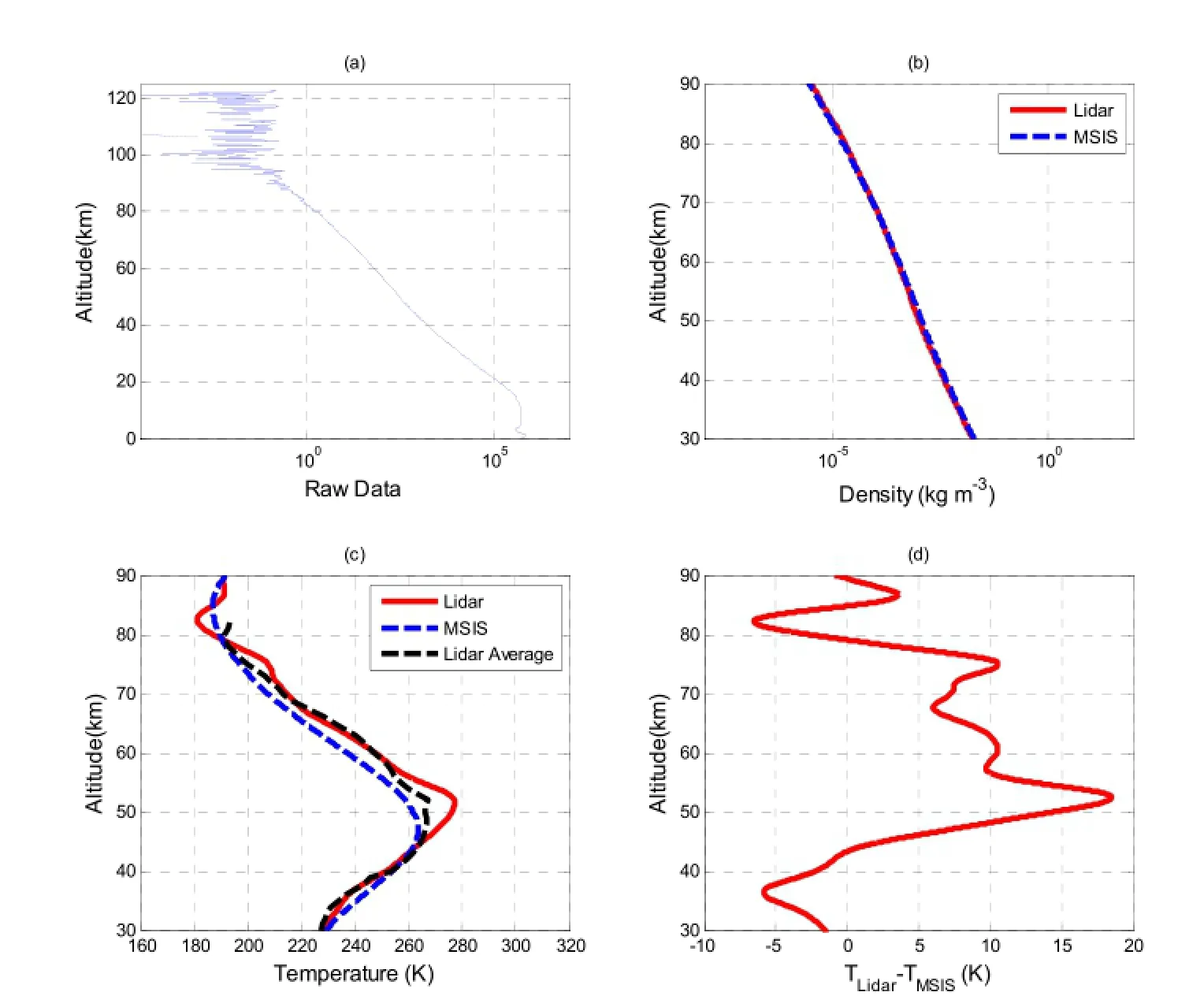Initial Results of Lidar Measured Middle Atmosphere Temperatures over Tibetan Plateau
QIAO Shuai, PAN Weilin, ZHU Ke-Yun, ZOU Rong-Shi, and TAN Jing
1Key Laboratory of Middle Atmosphere and Global Environment Observation (LAGEO), Institute of Atmospheric Physics, Chinese Academy of Sciences, Beijing 100029, China
2Department of Atmospheric Sciences, Chengdu University of Information Technology, Chengdu 610225, China
Initial Results of Lidar Measured Middle Atmosphere Temperatures over Tibetan Plateau
QIAO Shuai1,2, PAN Weilin1, ZHU Ke-Yun2, ZOU Rong-Shi1, and TAN Jing1,2
1Key Laboratory of Middle Atmosphere and Global Environment Observation (LAGEO), Institute of Atmospheric Physics, Chinese Academy of Sciences, Beijing 100029, China
2Department of Atmospheric Sciences, Chengdu University of Information Technology, Chengdu 610225, China
During August 2013, a mobile Rayleigh lidar was deployed in Lhasa, Tibet (29.6°N, 91.0°E) for making measurements of middle atmosphere densities and temperatures from 30 to 90 km. In this paper, the authors present the initial results from this scientific campaign, Middle Atmosphere Remote Mobile Observatory in Tibet (MARMOT), and compared the results to the MSIS-00 (Mass Spectrometer and Incoherent Scatter) model. This work will advance our understanding of middle atmosphere dynamic processes, especially over the Tibetan Plateau area.
lidar, middle atmosphere, temperature, Mass Spectrometer and Incoherent Scatter model
1 Introduction
Temperature is a key factor for understanding the chemical, dynamic, and radiative processes in the atmosphere. The thermal structure in the middle atmosphere has a close connection with atmospheric ozone and related photochemical reactions. However, atmospheric temperature is affected by waves (gravity waves, tides, and planetary waves) and atmospheric circulation (Lü and Chen, 2003; Wang, 2011). Observations and modeling indicate gradual cooling in the middle atmosphere (Ramaswamy et al., 2001), and the formation of mid-latitude noctilucent clouds may be a harbinger of global climate change (Herron et al., 2007). Therefore, temperature profiling is of great importance for studying middle atmosphere temperature variations and for validating the current atmospheric models (Pan and Gardner, 2002).
The middle atmosphere between 30 and 90 km is higher than the detectable range for aircraft and sounding balloons. Rocket can probe one vertical profile at a certain point in time, and the cost is relatively high (Keckhut et al., 1995). But Rayleigh lidar, with its high spatial and temporal resolution (Chanin, 1984; Gobbi et al., 1995; Yan, 2001), is an effective means for measuring vertical temperature profiles in the middle atmosphere (Shibata et al., 1986; Gardner, 1989, 2001; Hauchecorne and Chanin,1991; Hauchecorne et al., 1992).
The Middle Atmosphere Remote Mobile Observatory in Tibet (MARMOT) lidar was recently developed by the Institute of Atmospheric Physics (IAP), Chinese Academy of Sciences (CAS). In this paper, we will describe the MARMOT lidar system and our lidar data retrieval method, and show some preliminary results of middle atmosphere temperature measurements over Lhasa, Tibet.
2 Lidar system description and data retrieval method
The MARMOT lidar consisted of three parts: laser transmitter unit, optical receiver unit, and signal acquisition & control unit. A block diagram of the MARMOT lidar system is shown in Fig. 1.
The main part of the laser transmitter was a Nd:YAG laser working at wavelengths of both 532 nm and 1064 nm. The optical receivers were a prime focus telescope ofФ1000 mm diameter and a Newtonian telescope ofФ200 mm diameter. Lidar backscattered signals of 532 nm and 1064 nm were collected by the prime focus telescope and then detected by one Photomultiplier Tube (PMT) and one Avalanche Photodiode (APD), respectively. The Newtonian telescope and another PMT received lidar signals of 532 nm. Signals from these optical detectors were then collected by transient recorders and stored as binary files in the computer.
In MARMOT lidar system, we used dual telescope configuration to collect the 532 nm signals. Signals received by the large-aperture prime focus telescope covered the 50-90 km altitude range. An optical chopper in the receiver blocked lidar signals below 50 km in order to avoid PMT saturation caused by strong lidar return signals from low altitudes. For signals below 50 km, we used a Newtonian telescope with smaller aperture. During this experiment, the high-altitude 532 nm signal could reach 50-90 km, and the low-altitude 532 nm signal could reach 30-60 km. Thus, we were able to obtain a 532 nm Rayleigh signal profile for altitudes between 30 and 90 km. Results from the 1064 nm signal are not discussed in this paper. The system specifications for the MARMOT lidar are shown in Table 1.

Figure 1 Block diagram of the MARMOT lidar system.

Table 1 Specifications of the MARMOT lidar system.
The main principle of Rayleigh temperature derivation is as follows. Considering that the aerosol content is extremely low above 30 km, the lidar backscattered signal mainly comes from Rayleigh scattering by gaseous molecules. By calculating the atmospheric backscattered signals, we can get the relative density profile in the atmosphere. If we assume the atmospheric temperature at a higher altitude (~ 90 km, in our case) can be taken from the Mass Spectrometer and Incoherent Scatter (MSIS-00) model, then by combining the ideal gas law and the hydrostatic equation, atmospheric temperature profiles can be derived from relative density profiles (Hauchecorne and Chanin, 1980; Liu et al., 2006).
3 Middle atmosphere density and temperature profiles over Lhasa
In August 2013, the MARMOT lidar was operated in Lhasa, Tibet (29.6°N, 91.0°E), for 23 days, obtaining approximately 135 h of valid data. In this paper, we used 1-h lidar data between 22:20 and 23:30 local time (LT) on 22 August 2013 to derive and analyze the middle atmosphere density and temperature over Lhasa. These 1-h lidar data were chosen for their relatively high signal to noise ratio (SNR) and relatively stable background noise.
Figure 2a shows the high-altitude 532 nm signal, representing the raw photon counts from 50 to 90 km. The derived density and temperature are plotted in Figs. 2b and 2c, respectively. The differences between temperatures derived from lidar (Tlidar) and temperatures from the MSIS-00 model (TMSIS) are shown in Fig. 2d. We can see that the derived temperature and MSIS-00 temperature agreed well for altitudes of 55-80 km, while the derived temperature was slightly warmer than the MSIS-00 model above 80 km. The derived temperature was 1-12 K warmer than the model from 55 to 78 km and 85 to 88 km, but was 1-8 K colder than the model from 79 to 85 km.
Figure 3a shows the low-altitude 532 nm signal, representing raw photon counts from 30 to 60 km. The derived density and temperature are plotted in Figs. 3b and 3c, respectively. The differences betweenTlidarandTMSISare shown in Fig. 3d. We can see that the derived temperature and MSIS-00 temperature agreed well from 30 to 45 km. The derived temperature was 1-7 K colder than the model from 30 to 40 km.
We combined the smoothed high-altitude 532 nm (from 50 to 90 km) and low-altitude 532 nm signals (from 30 to 60 km) together using normalization method, that is, by normalizing the high-altitude 532 nm signals and the low-altitude 532 nm signals by their corresponding signal levels at a certain altitude (~ 51 km, in our case), and then“stitching” them together to obtain a continuous altitude coverage of 532 nm lidar signals from 30 to 90 km. Then, the relative photon counts for this altitude range are plotted in Fig. 4a. Figure 4b shows the derived density pro file. Figure 4c shows the derived temperature profile forthis 1 h observation period, as well as the monthly mean lidar temperature profile obtained during 8-24 August 2013 in Lhasa. The differences betweenTlidarandTMSISare plotted in Fig. 4d. Between 55 and 80 km, the derived temperature agreed well with the model.Tlidarwas 1-18 K warmer thanTMSISbetween 42 km and 79 km, but 1-7 K colder from 30 to 42 km and 79 to 85 km.

Figure 2 Observation results from the high-altitude 532 nm channel on 22 August 2013: (a) raw photon counts from lidar measurements, (b) density profiles, (c) temperature profiles, and (d) the difference between lidar measured temperature and MSIS-00 temperature. In (b) and (c), red solid line for lidar measurements, blue dashed line for MSIS-00 model.

Figure 3 Observation results from the low-altitude 532 nm channel on 22 August 2013: (a) raw photon counts from lidar measurements, (b) density profiles, (c) temperature profiles, and (d) the difference between lidar measured temperature and MSIS-00 temperature. In (b) and (c), red solid line for lidar measurements, blue dashed line for MSIS-00 model.

Figure 4 The results combining the high-altitude 532 nm and the low-altitude 532 nm channels on 22 August 2013: (a) raw photon counts from lidar measurements, (b) density profiles, (c) temperature profiles, and (d) the difference between lidar measured temperature and MSIS-00 temperature. In (b) and (c), red solid line for lidar measurements, blue dashed line for MSIS-00 model.
4 Discussions
Our MARMOT lidar has made successful measurements of middle atmosphere density and temperature profiles in Lhasa, Tibet. The derived lidar temperatures from 30 km to 90 km ranged from 7 K colder to 18 K warmer than the MSIS-00 model. This discrepancy could be caused by atmospheric waves, and/or the inaccuracy of the MSIS-00 model. Our preliminary results have suggested some limitations of the MSIS-00 model, since the model was developed under the circumstances that not much middle atmosphere observational data was available over the Tibetan Plateau. Therefore, lidar measurements could provide an effective tool for improving current atmospheric modeling. Furthermore, lidar observational data could become a unique dataset for better understanding the middle atmosphere thermal structure, the waves, and the processes of momentum and energy exchange within layers. We plan to upgrade our lidar system by improving data quality and by extending altitude coverage.
Acknowledgements. This work was supported by the National Natural Science Foundation of China (NSFC) (Grant No. 41127901), the National Basic Research Program of China (973 program, Grant No. 2010CB428601), and the “100 Technical Talents” Program of the Chinese Academy of Sciences (CAS). The authors would like to acknowledge CHEN Xuewu, LIU Linmei, YANG Yong from the Wuhan Institute of Physics and Mathematics (WIPM) of CAS, and WANG Jihong from the National Space Science Center (NSSC) of CAS for their technical support during the MARMOT lidar campaign. We are also thankful to the Tibetan Plateau Research of CAS for providing the observation site.
Chanin, M. L., 1984: Review of lidar contributions to the description and understanding of the middle atmosphere,J. Atmos. Terr. Phys., 46, 987-993.
Gardner, C. S., G. C. Papen, X. Chu, et al., 2001: First lidar observations of middle atmosphere temperatures, Fe densities, and polar mesospheric clouds over the North and South Poles,Geophys. Res. Lett., 28, 1199-1202.
Gardner, C. S., D. C. Senft, T. J. Beatty, et al., 1989: Rayleigh and sodium lidar techniques for measuring middle atmospheric density, temperature and wind perturbations and their spectra, in:Worm Ionosphere/Thermosphere Study Handbook, C. H. Liu and B. Edwards (Eds.), International Congress of Scientific Unions, Urbana, 148-187.
Gobbi, G. P., C. Souprayen, F. Congeduti, et al., 1995: Lidar observations of middle atmosphere temperature variability,Ann. Geophys., 13, 648-655.
Hauchecorne, A., and M. L. Chanin, 1980: Density and temperature profiles obtained by lidar between 30 and 70 km,Geophys. Res.Lett., 7, 565-568.
Hauchecorne, A., and M. L. Chanin, 1991: Climatology and trends of the middle atmospheric temperature (33-87 km) as seen by Rayleigh lidar over the south of France,J. Geophys. Res., 96(D8),15297-15309.
Hauchecorne, A., M. L. Chanin, P. Keckhut, et al., 1992: LIDAR monitoring of the temperature in the middle and lower atmosphere,Appl. Phys.B, 55, 29-34.
Herron, J. P., V. B. Wickwar, P. J. Espy, et al., 2007: Observations of a noctilucent cloud above Logan, Utah (41.7°N, 111.8°W) in 1995,J. Geophys. Res., 112, D19203, doi:10.1029/2006JD007158.
Keckhut, P., A. Hauchecorne, and M. L. Chanin, 1995: Midlatitude long-term variability of the middle atmosphere trends and cyclic and episodic changes,J. Geophys. Res., 100, 18887-18897.
Liu, X., S. X. Hu, N. Q. Weng, et al., 2006: Algorithm analysis on atmosphere temperature detected by rayleigh laser lidar,J. At-mos. Environ. Optics(in Chinese), 1(3), 188-192.
Lü, D., and H. Chen, 2003: Advances in middle atmosphere physics research,Chinese J. Atmos. Sci.(in Chinese), 27(4), 750-769.
Pan, W., and C. S. Gardner, 2002: The temperature structure of the winter atmosphere at South Pole,Geophys. Res. Lett., 29(16), 4901-4904.
Ramaswamy, V., M. L. Chanin, J. Angell, et al., 2001: Stratospheric temperature trends observations and model simulations,Rev. Geophys., 39(1), 71-122.
Shibata, T., M. Kobuchi, and M. Maeda, 1986: Measurements of density and temperature profiles in the middle atmosphere with a XeF lidar,Appl. Opt., 25, 685-688.
Wang, Z. H., 2011:Atmospheric Sounding, China Meteorological Press, Beijing, 380pp.
Yan, J., 2001:Environmental Monitoring Lidar, China Science Press, Beijing, 239pp.
:Qiao, S., W. Pan, K.-Y. Zhu, et al., 2014: Initial results of lidar measured middle atmosphere temperatures over Tibetan Plateau,Atmos. Oceanic Sci. Lett., 7, 213-217,
10.3878/j.issn.1674-2834.13.0114.
Received 31 December 2013; revised 3 February 2014; accepted 11 February 2014; published 16 May 2014
PAN Weilin, panweilin@mail.iap.ac.cn
 Atmospheric and Oceanic Science Letters2014年3期
Atmospheric and Oceanic Science Letters2014年3期
- Atmospheric and Oceanic Science Letters的其它文章
- Characteristics of a Negative Cloud-to-Ground Lightning Discharge Based on Locations of VHF Radiation Sources
- Surface Trace Gases at a Rural Site between the Megacities of Beijing and Tianjin
- Optimal Forward-Scattering Angles of Atmospheric Aerosols in North China
- Variation Trend and Characteristics of Anthropogenic CO Column Content in the Atmosphere over Beijing and Moscow
- Concurrent Upward Lightning Flashes from Two Towers
- Stratospheric Aerosol Extinction Profile Retrieval from SCIAMACHY Limb Measurements
